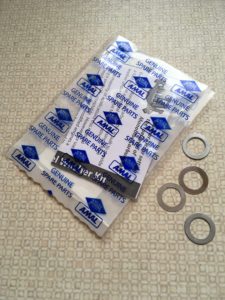My G3LS has an Amal 376 monobloc carburettor, it’s not the correct one for the bike, but it works and many people use them when the original carburettor wears out.
Before putting the bike back on the road in 2020, I’d stripped and cleaned the carburettor; always a good idea if your bike has been standing for a while. I also fitted an overhaul kit and all seemed well. After my exploits with the dynamo sprocket and subsequent disaster, there was fuel dripping from the carburettor; purely coincidence.
This can be several things such as a stuck or damaged needle valve, or in my case, the needle valve was only just closing…most of the time. I removed the float chamber cover and discovered that the copper float had developed a small dimple where the original needle insert had been resting (and moving slightly) on it. I’d estimate the dimple was about 0.5mm but that multiplies up as you move away from the fulcrum to the end of the float. The float just hit the top of the chamber as the needle valve just closed.
I could have replaced the copper float, but it was otherwise perfect, or I could have repaired the dimple. The easiest and cheapest way to fix the problem was to buy a washer fuel level setting kit from Amal part number RKC/SHIM. This consists of a set of washers of varying thickness which are placed under the valve seat housing, where it screws in to the carburettor float chamber. It’s designed for use in engines that have the carburettor at an angle or are used for competition work.
Setting the correct fuel level is fairly straight forward. Some people actually make a perspex float chamber cover! The fuel level is supposed to be just above half full before the needle valve closes. I let my float ‘float’ in petrol with a hooked paperclip to simulate the pivot. The fuel came half way up the side of the float. The final step was to replace the thick original washer, with some from the kit to make sure the needle valve closed at the right time, taking into account the correct fuel level. Once done, the cover was replaced and a test with fuel indicated all was well. I replaced the old plastic banjo with a new metal one from Amal too. Now for the tinks.
